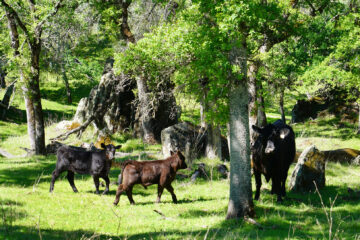Conservation and grazing don’t always go hand in hand. There are benefits and drawbacks, but like any good relationship there is a place in the middle that can make both partners happy.
Placer Land Trust began working with Imbach Ranch (Ron, Ryan and Tracy Schohr) in 2012. Prior to that, we worked with Dan Macon who ran his sheep and the Imbach’s cattle on our 426 acre Doty Ravine Preserve. Dan and his animals left the Preserve in excellent condition and we wanted to continue this transformation from an overgrazed and biologically degraded property to one of higher biodiversity, ecological function and productivity for the rancher.
Going back a few years to 2008…we planted 5,000 trees and shrubs in a 20-acre section of floodplain along Doty Ravine in partnership with Westervelt Ecological Services on our Doty Ravine Preserve. Over time this floodplain transformed from a seasonally green but low productivity area to one of high biodiversity that stays green year round. Originally, it was off-limits to cattle grazing during the establishment period, which took a few years to allow the trees and shrubs to grow. Now, the cows are using the floodplain during the late fall and early summer when upland feed has turned brown and lost nutrition, since the floodplain area is still green and lush.
This grazing system brings much needed protein to the livestock and may eventually extend the grazing season on the Preserve. The flash grazing done by the cattle helps reduce thatch (last year’s grass growth) and helps young trees to find sunlight and room to grow. Once fully established, the livestock will also help control the number of new trees added to the system which will help maintain a balance between wetlands, grassland and riparian tree cover.
We are currently working with US Fish and Wildlife Service on a similar restoration project on the other side of the creek totaling approximately 36 acres. The folks at Imbach Ranch has been instrumental in the planning and construction phases of this new project. By including the ranching operation in the restoration project planning, we are able to ensure that not only are we restoring natural habitat and ecological functions, but we’re providing an economically viable product for the rancher at the

The floodplain before the the trees and shrubs were established, shortly after planting.
same time. It’s important not to leave the ranchers out of the discussion as they play an important role in the preserve management, which has enabled us to manage these working landscapes in a sustainable manner.
The photo below is the floodplain before the the trees and shrubs were established, shortly after planting. The photo above is a recent photo showing how much growth has taken place since 2008 when they were planted.
7/18/2017

